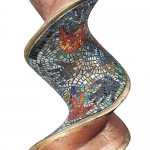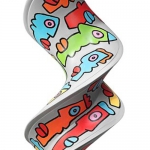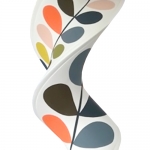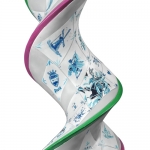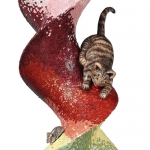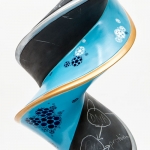For this item, I have David Bruggeman’s Sept. 24, 2015 posting on his Pasco Phronesis blog to thank,
As part of a fundraising project for a building at the Francis Crick Institute, Christie’s will hold an auction for 30 double-helix sculptures on September 30 (H/T ScienceInsider).
David has embedded a video featuring some of the artists and their works in his posting. By contrast, here are a few pictures of the DNA (deoxyribonucleic acid) art objects from the Cancer Research UK’s DNA Trail page,
For our London Art trail, which ran from 29 June – 6 September 2015, we asked internationally renowned artists to design a beautiful double helix sculpture inspired by the question: What’s in your DNA? Take a look at their sculptures and find out more about the artists’ inspirations.
This one is called The Journey and is by Gary Portell,
His inspiration is: “My design is based on two symbols, the swallow who shares my journey from Africa to England and the hand print. The hand print as a symbol of creation and the swallow reflects the traveller.
This one by Thiery Noir is titled Double Helix Noir.
The inspiration is: For this sculpture, Noir wanted to pay tribute to the memory of his former assistant, Lisa Brown, who was affected by breast cancer and who passed away in July 2001, at the young age of 31 years old.
Growing Stem is by Orla Kiely,
The inspiration is: I find inspiration in many things, but especially love nature with the abundance of colourful flowers, leaves, and stems. Applying our multi stem onto the DNA spiral seemed a natural choice as it represents positivity and growth: qualities that are so relevant for cancer research.
Double Dutch Delftblue DNA is by twins, Chris and Xand van Tulleken.
The inspiration is: The recurrent motifs of Delft tiles reference those of DNA. Our inspiration was the combination of our family’s DNA, drawing on Dutch and Canadian origins, and the fact that twins have shared genomes. (With thanks to Anthony van Tulleken)
Ted Baker’s Ted’s Helix of Haberdashery,
Inspiration is: Always a fan of spinning a yarn, Ted Baker’s Helix of Haberdashery sculpture unravels the tale of his evolution from shirt specialist to global lifestyle brand. Ted’s DNA is represented as a cascading double helix of pearlescent buttons, finished with a typically playful story-telling flourish.
Finally, What Mad Pursuit is by Kindra Crick,
Inspiration is: What Mad Pursuit explores the creative possibilities achievable through the intermingling of art, science and imagination in the quest for knowledge. The piece is inspired by my family’s contribution to the discovery of the structure of DNA.
Aparna Vidyasagar interviewed Kindra Crick in a Sept. 24, 2015 Q&A for ScienceInsider (Note: Links have been removed),
Kindra Crick, granddaughter of Francis Crick, the co-discoverer of DNA’s structure, is one of more than 20 artists contributing sculptures to an auction fundraiser for a building at the new Francis Crick Institute. The auction is being organized by Cancer Research UK and will be held at Christie’s in London on 30 September. The auction will continue online until 13 October.
The new biomedical research institute, named for the Nobel laureate who died in 2004, aims to develop prevention strategies and treatments for diseases including cancer. It is a consortium of six partners, including Cancer Research UK.
Earlier this year, Cancer Research UK asked about two dozen artists—including Chinese superstar Ai Weiwei—to answer the question “What’s in your DNA?” through a sculpture based on DNA’s double helix structure. …
Q: “What’s in your DNA?” How did you build your sculpture around that question?
A: When I was given the theme, I thought this was a wonderful project for me, considering my family history. Also, in my own art practice I try to express the wonder and the process of scientific inquiry. This draws on my backgrounds; in molecular biology from when I was at Princeton [University], and in art while going to the School of the Art Institute of Chicago.
I was influenced by my grandparents, Francis Crick and Odile Crick. He was the scientist and she was the artist. My grandfather worked on elucidating the structure of DNA, and my grandmother, Odile, was the one to draw the first image of DNA. The illustration was used for the 1953 paper that my grandfather wrote with James Watson. So, there’s a rich history there that I can draw from, in terms of what’s in my DNA.
…
Should you be interested in bidding on one of the pieces, you can go to Christie’s What’s in your DNA webpage,
ONLINE AUCTION IS LIVE: 30 September – 13 October 2015
Good luck!
David Bruggeman has put in a request (from his Sept. 24, 2015 posting),
… if you become aware of human trials for 3D bioprinting, please give a holler. I may now qualify.
Good luck David!
